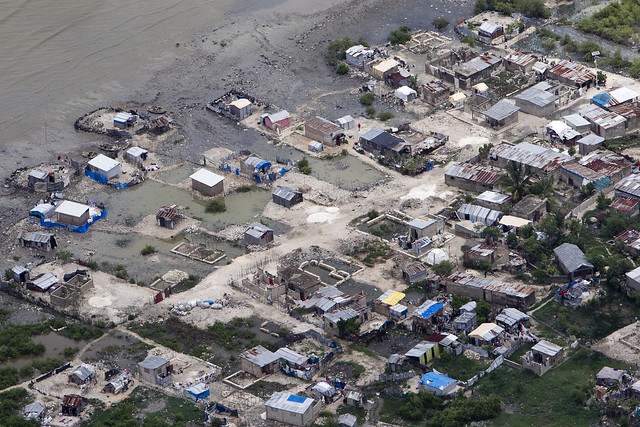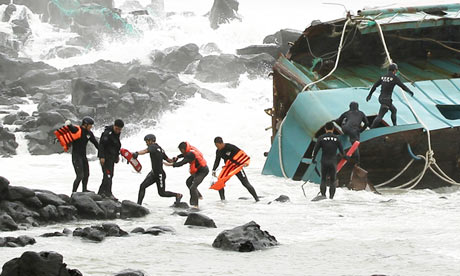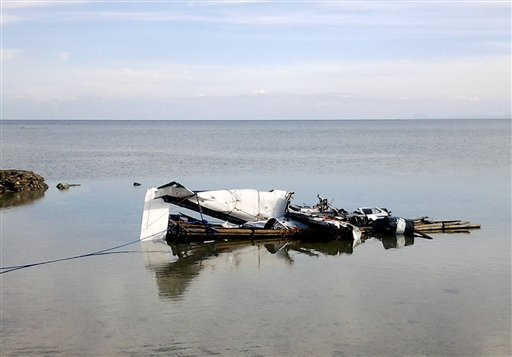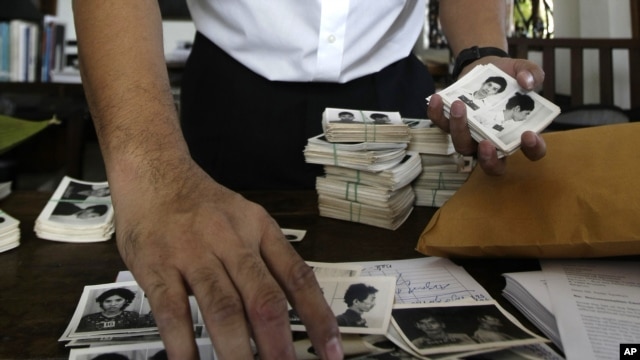DO DONTREI, Cambodia — It was four grey skulls resting on a bed of jumbled bones that again triggered Chea Nouen's memories: breast-feeding her baby with her hands and feet shackled; her husband thrown into a pit to be turned into human fertilizer, her own marches to the killing fields — where she was saved three times by an executioner.
The past came hurtling back earlier this month when a new mass grave was discovered in this village in northwestern Cambodia, one of the bloodiest killing grounds in the country. Like most of Cambodia's some 300 known mass grave clusters, it is not being investigated or exhumed to find out what happened.
More than three decades after the Khmer Rouge ultra-revolutionaries orchestrated the deaths of nearly 2 million people, or one out of every four Cambodians, this country has not laid its ghosts to rest. Cambodia's regime prefers to literally bury the past, especially since some of its current leaders, including Prime Minister Hun Sen, were once Khmer Rouge.
But 63-year-old Chea Nouen and other survivors in this small, farming community cannot forget, hold their tears in check or banish the nightmares when they daily tread over the unexamined bones of 35,000 victims and live among restless souls that still hover, they believe, over homes and rice fields. Also unfinished is the pursuit of justice: Neither the three top Khmer Rouge leaders nor local executioners have been punished, with the exception of a controversial jail sentence of 19 years for the former prison chief known as Comrade Duch.
In April, Chea Nouen was invited to the capital, Phnom Penh, to hear a top Khmer Rouge official, Nuon Chea, offer his defense to a U.N.-backed tribunal: I didn't know. I was just carrying out orders. It's an exaggeration. The U.N. and the tribunal say they are following the law. But Chea Nouen calls the trial "an absurdity," incredulous that it has taken six years, $160 million and mountains of documents to prove a case against three now feeble octogenarians when all seems so starkly clear to the villagers at Do Dontrei.
"At my age and health, I cannot confront the Khmer Rouge, " says the 63-year-old woman. "But I would be pleased to tell my story."
Her body is almost skeletal and wracked by persistent illnesses from the Khmer Rouge years, but Chea Nouen's animated face, striking poses and still supple hands conjure up the past in powerful pantomime.
She contorts her body, demonstrating how her legs and arms were bound to an iron bar. Her face grimaces in remembered pain. A soldier points a pistol to her temple, another searches her body for hidden valuables. In shock, she drops her 2-month-old son to the prison floor. For seven days, almost sleepless and surviving on just water, she cradles her child, twisting her body to allow him to suckle at her breasts. Chea Nouen, back in the present, brushes tears away with a yellow towel.
Their family, with two children, had been arrested one morning while riding in an ox-cart. A day after her release, her husband was taken away to the foot of a hill, close by the recently discovered grave, where the Khmer Rouge vented their hatred of former government soldiers like him with singular fury.
Blindfolded, hands tied behind their backs, they were savagely beaten, slashed with machetes and pushed into pits stocked with rice husks that were set ablaze. The ashes and decomposed bodies fused into fertilizer to be scattered over the rice fields.
Although still under official arrest, Chea Nouen was released to a Khmer Rouge complex that included dormitories, a warehouse and communal dining. She grew vegetables, worked grueling hours in the rice paddies and kitchen. One of her sons succumbed to illness, the other died of starvation.
Of the hundreds of workers who passed through the center, all of them women, only seven survived the deprivation and a methodical killing machine not unlike those at Nazi concentration camps. Executions took place once or twice a week, with batches of 60 to 80 prisoners, and often timed to the fertilizer production.
"We are all just like fish in the water. One day they will hook us all," she told a co-worker who sensed her own time had come and asked Chea Nouen to take gold she had secreted to pass on one day to her children. Chea Nouen declined, believing she herself wouldn't survive. The following day, after the evening meal, her friend disappeared.
Chea Nouen rises, head bent to the ground, her arms clasped behind her as if pinioned by ropes. She is trudging off with a line of others toward the pits. The killers await them, naked torsos sweating. She hears shouts, wailing and cursing from those about to die. Then, the chief of the execution squad, a man she had provided with bath water, halts the file of prisoners.
"I don't know why he was so kind and saved my life. He did it three times. Maybe he felt sympathy for me. Maybe he loved me," she says. Nhorn was the only name she knew him by, and after the Khmer Rouge downfall she never saw him again.
"Whenever I think of the Khmer Rouge time I don't feel hunger or thirst," she says, sinking into her chair in a ramshackle hut open to the rains and mosquitoes. "I feel nothing except the feeling that I am already dead."
She has a proper house in the village, home to some 600 people, but prefers the forest retreat where she can better raise chickens, ducks and four cows, and where there is a peace and quiet for which she longs.
Her face still flushed, Chea Nouen ends her story on a lighter note, relating how a ghost appeared in the dream of the businessman who bought the land with the skulls from a farmer, one day after the remains were found. The spectral visitor recommended he go for the number 50 in a lottery. He won $1,500 and paid for a ceremony at the newly-found grave.
"My husband never comes to see me or give me a winning lottery number, so I'm still poor," she laughs. "I didn't even pray for a lottery number at the ceremony. I just thanked the spirits for saving my life."
The remains from the grave were placed in a makeshift shrine under the shade of three palm trees, and the villagers of Do Dontrei brought soup, rice, desserts and a little money to the crude altar as offerings.
They worry that the spirits are troubled. There is a widespread belief in Cambodia that the bones of the deceased — especially those who met violent deaths — should be collected, cremated and prayed over lest they remain in the place they died to haunt the living.
But rural folk — the "little people," as they have been called — still have little voice or legal recourse in face of rich power-brokers, and the businessman who purchased the land for $4,700 for construction has close connections in the nearby provincial capital of Siem Reap. So the digging continues.
Khung Leang, a handsome 53-year-old woman with a ready smile, says she may never know where her entire family lies. She conducted rites for their souls, but they still return to her in disturbing dreams.
"They stood here. But they refused to come up," she says, sitting on steps leading to the first story of her stilt-propped house. "My father said, 'I can't enter because there is a stick in the house and I will be beaten.' I didn't know, but there was actually one there. I threw it away, and a few days later they came again. And again they refused to come into the house. My father just stood on these steps, crying."
Khung Leang thinks of the "crimes" that led to the slaughter of her mother, her father and all six of her siblings. They had been damned as "rich capitalists" because they sold sweets in the market. Later, they were discovered eating chicken soup one night as a family, violating bans on private property and eating outside communal quarters. The last of her father's three "crimes" was "destroying Khmer Rouge property" by failing to stop cows he was ordered to herd from grazing in a rice field.
Her father was taken away first. She doesn't know how he died. Later she was told that before his execution, he pleaded with friends: "Please take care of my daughter. She will soon be alone."
And she was. They all followed him, even the youngest, her four-year-old sister, because the Khmer Rouge liked to say: "If you don't want grass to grow you have to pull out all the roots underneath."
Like Chea Nouen, she regards her cheating of death — twice — as miraculous.
Like many women and despite protest, she was forced into marriage with a man the Khmer Rouge had chosen for her. And like many young couples, they were assigned to a mobile brigade, tasked with back-breaking work in remote areas after separation from their families. She was away when her family was exterminated.
Sometime later, she and others were being herded to an execution site when a Khmer Rouge cadre suddenly barked, "That is enough. We have reached our quota today. Take the others back."
A cooling evening breeze sweeps through the garden around Khung Leang's home as she finishes her tale, one with a happy ending. A sprightly little girl, one of six grandchildren, rushes into her arms. A handsome 23-year-old son returns from teaching school.
Their family makes ends meet, growing rice and vegetables and still selling the traditional sweets from rice and palm sugar that once precipitated the tragedy. Her husband — the same she once adamantly rejected — drives a motorcycle taxi.
"He is a very kind-hearted man," she says.
Pools of stagnant, milky green water lay at the bottom of the burial pits. The backhoe gouged out more earth.
"If the investigators don't come and conduct a proper search, all the remains will soon disappear," said farmer Chhorn Kry, standing at the grave's edge, near where nine members of his wife's family were executed.
The survivors of Do Dontrei believe the spirits are still trapped. They say the graves must be opened, with proper rites, so that the spirits can fly, look for their relatives and ascend to heaven. Chea Nouen compares it to water flowing out after a bottle is opened.
Khung Leang adds a contemporary, political twist to the ancient belief: "There are many souls still with us here. They are wandering around our village, hovering above us, because they are still waiting for justice."
Thursday 23 August 2012
http://www.waxahachietx.com/apnews/world/mass-grave-raises-ghosts-from-the-past/article_d7877476-ecb3-11e1-8257-0019bb2963f4.html






























